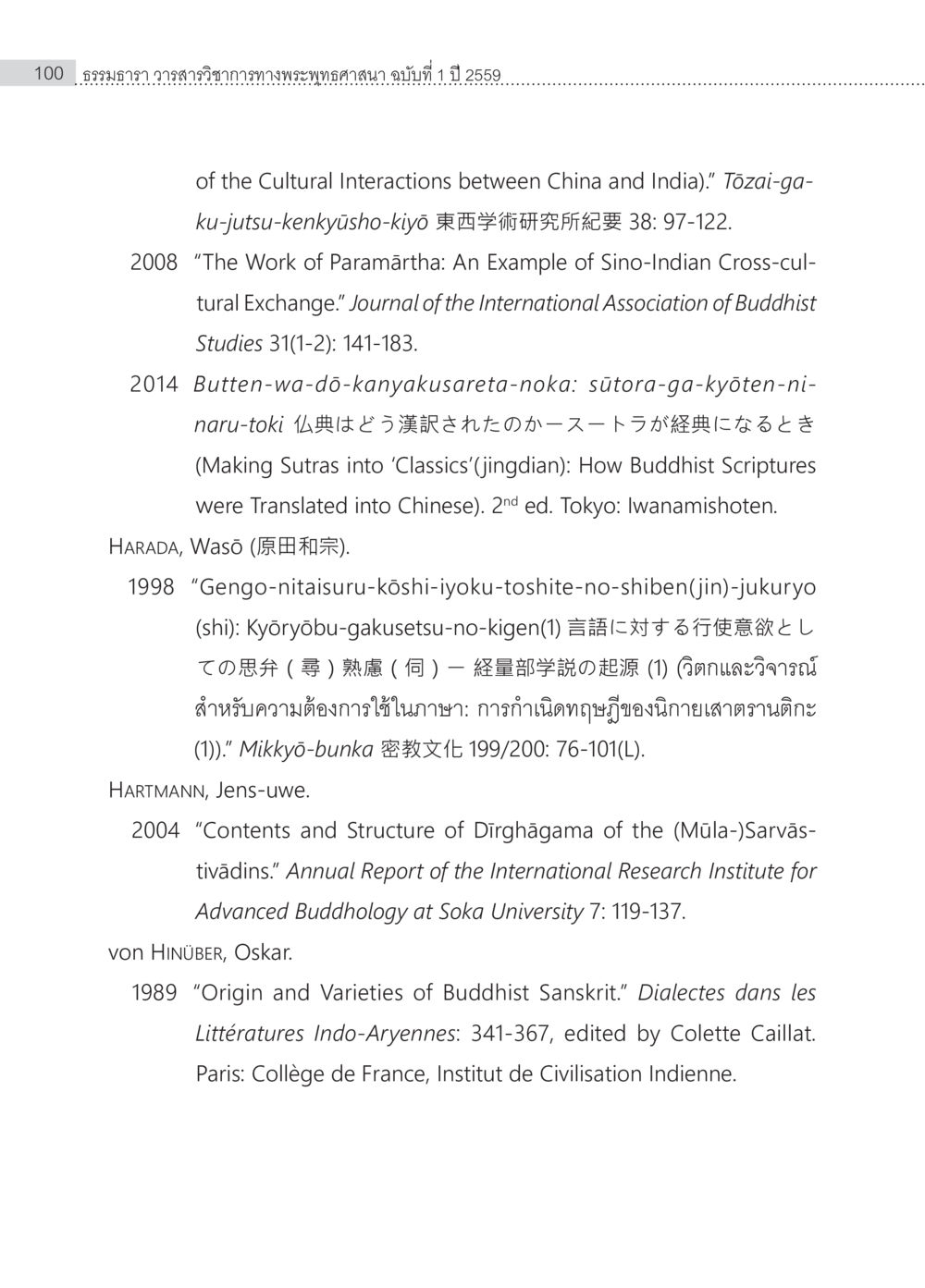Interactions Between Chinese and Indian Buddhist Cultures : หน้า 34/37
Samayabhedoparacanacakra คำแปลพร้อมเชิงอรรถวิเคราะห์(1) : หน้า 34/37 Exploring cultural exchanges and transformations in the transmission of Buddhist texts from India to China.
2 ครั้ง

สรุปเนื้อหา
บทความนี้สำรวจการแลกเปลี่ยนวัฒนธรรมระหว่างจีนและอินเดีย โดยมุ่งเน้นไปที่การทำงานของ Paramārtha และวิธีการที่คัมภีร์ศาสนาพุทธได้รับการแปลเป็นภาษาจีน อ้างอิงจากบทความวารสารและหนังสือต่างๆ การศึกษาวิจัยนี้ให้ข้อมูลเชิงลึกเกี่ยวกับโครงสร้างและเนื้อหาของ Dirghagama และต้นกำเนิดของภาษาศาสตร์พุทธแบบสันสกฤต.
หัวข้อประเด็น
-การแลกเปลี่ยนวัฒนธรรมจีนและอินเดีย
-การแปลคัมภีร์ศาสนาพุทธ
-งานวิจัยของ Paramārtha
-Dirghagama ของ Sarvāstivādin
-ต้นกำเนิดของภาษาศาสตร์พุทธ
ข้อความต้นฉบับในหน้า
100
ฎรรมถาภาว วารสารวิชาการทางพระพุทธศาสนา. ฉบับที่ 1 ปี 2559
of the Cultural Interactions between China and India." Tōzai-ga-ku-jutsu-kenkyūsho-kiyō 東西学術研究所紀要 38: 97-122.
2008 "The Work of Paramārtha: An Example of Sino-Indian Cross-cultural Exchange." Journal of the International Association of Buddhist Studies 31(1-2): 141-183.
2014 Butten-wa-dō-kanyakusareta-noka: sūtra-ga-kyōten-ni-naru-toki 仏典はどう漢訳されたのか—ストラが典になるとき (Making Sutras into ‘Classics’(jingdian): How Buddhist Scriptures were Translated into Chinese). 2nd ed. Tokyo: Iwanamishoten.
HARADA, Wasō (原田和宗).
1998 "Gengo-nitaisuru-kōshi-iyoku-toshite-no-shiben(jin)-jukuryo (shi): Kyōryōbu-gakusetu-no-kigen(1) 言語に対する行使欲とし
ての思牽(尋)熟慮(伺)—経量部学説の起源(1) (視Aและวิจารณ์สำหรับความต้องการใช้ในภาษา: การกำเนิดทฤษฎีของกายาสมาธิ). 玲得และวิจารณ์สำหรับความต้องการใช้ในภาษา: การกำเนิดทฤษฎีของกายาสมาธิ. (1)". Mikkyō-bunka 密教文化 199/200: 76-101(L).
HARTMANN, Jens-uwe.
2004 "Contents and Structure of Dirghagama of the (Mūla-)Sarvāstivādin." Annual Report of the International Research Institute for Advanced Buddhology at Soka University 7: 119-137.
von HINÜBER, Oskar.
1989 "Origin and Varieties of Buddhist Sanskrit." Dialectes dans les Littératures Indo-Aryennes: 341-367, edited by Colette Caillat. Paris: Collège de France, Institut de Civilisation Indoenne.
หนังสือที่เกี่ยวข้อง
Load More





































